Best Tools for Removing Watch Backs: A Complete Guide
You’re staring at your watch with its dead battery, wondering if you really need to trek to the jeweler and shell out $20 for a five-minute job. The good news? With the right tools, you can easily remove watch backs at home, saving both time and money.
After years of maintaining my own watch collection and helping fellow enthusiasts do the same, I’ve learned which tools actually work and which aren’t worth your money. In this guide, I’ll walk you through everything you need to know about watch back removal tools—from budget finds to professional-grade equipment.
Contents
- Understanding Different Watch Back Types
- Essential Tools for Removing Every Watch Back Type
- Step-by-Step Guide to Removing Different Watch Backs
- Budget-Friendly Options That Actually Work
- Professional Tools Worth the Investment
- Common Mistakes and How to Avoid Them
- When to Call in the Professionals
- Final Thoughts
Understanding Different Watch Back Types
Before grabbing any tool, you need to identify what type of watch back you’re dealing with. This seemingly small detail determines your entire approach.
Snap-on backs are found on many affordable watches and have a thin lip where a case knife can slide under to pop them open. They typically have a smooth, flat appearance with no visible screws or notches.
Screw-down backs feature a threaded edge that twists off, often with notches or holes along the edge for tool gripping. You’ll recognize these by their circular grooves around the perimeter.
Multi-notch backs come with varying numbers of indentations (usually 2, 4, or 6) around the edge that require specific wrench attachments.
Rolex-style backs need specialized tools as they often have a fluted edge that requires a specific gripping pattern.
Four-pin backs contain small holes that require pins to engage and twist open, common in many water-resistant models.
Identifying your watch back type isn’t just helpful—it’s essential for choosing the right tool and avoiding damage to your timepiece.
Essential Tools for Removing Every Watch Back Type
1. Case Knife for Snap-on Backs
A case knife remains the simplest yet most effective tool for opening snap-on watch backs. Unlike actual knives, these blunt tools slide under the lip of the case without scratching the metal.
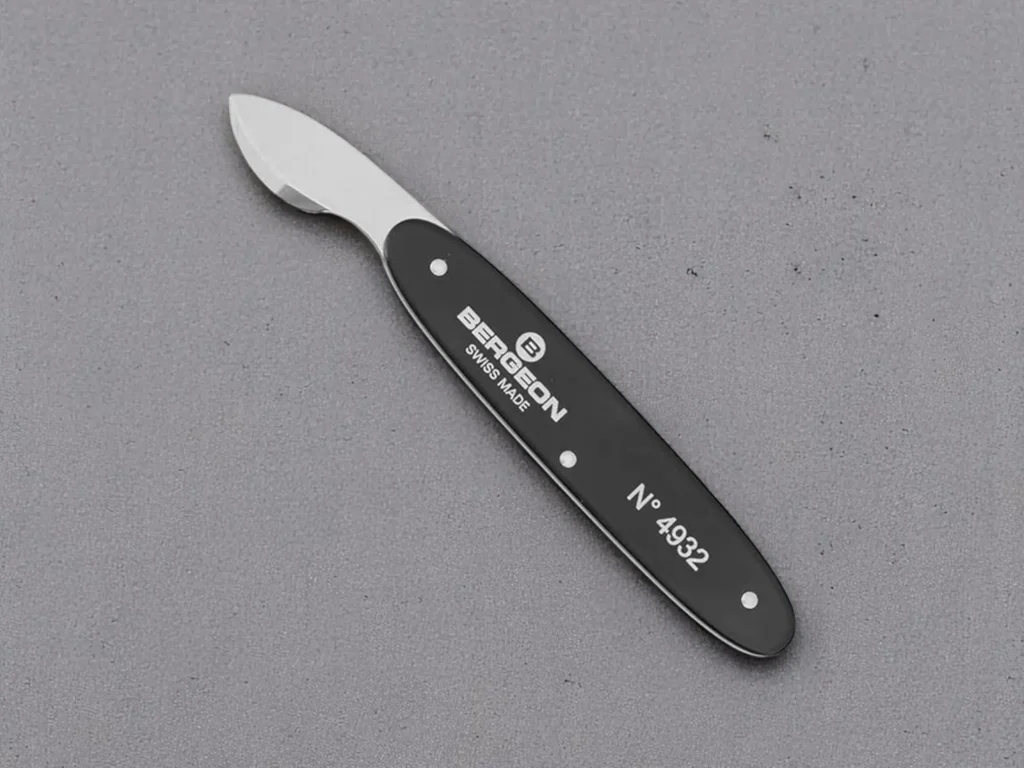
What makes a good case knife? Look for ones with:
- A thin but rigid blade (0.5mm is ideal)
- Polished edges to prevent scratching
- A comfortable handle for leverage
I’ve found that the Bergeon 4932 stands out among case knives—it offers the perfect balance between thinness and strength. For beginners, the slightly thicker Horotec Standard knife provides more stability while you’re learning.
2. Watch Back Ball for Screw Backs
This surprisingly simple tool—essentially a rubber ball with a grip—works wonders on screw-down backs. The friction between the ball and the watch case provides enough torque to unscrew many backs.

Top features in quality watch balls:
- High-friction rubber compound
- Right size (about 2 inches in diameter works for most watches)
- Slight tackiness without leaving residue
The Bergeon watch ball costs about $15, but honestly, many $5-8 options from Amazon work nearly as well.
3. Watch Back Wrench for Notched Backs
A watch back wrench (sometimes called a case wrench) features adjustable pins that fit into the notches on watch backs. The tool creates a secure grip that lets you apply even pressure while turning.
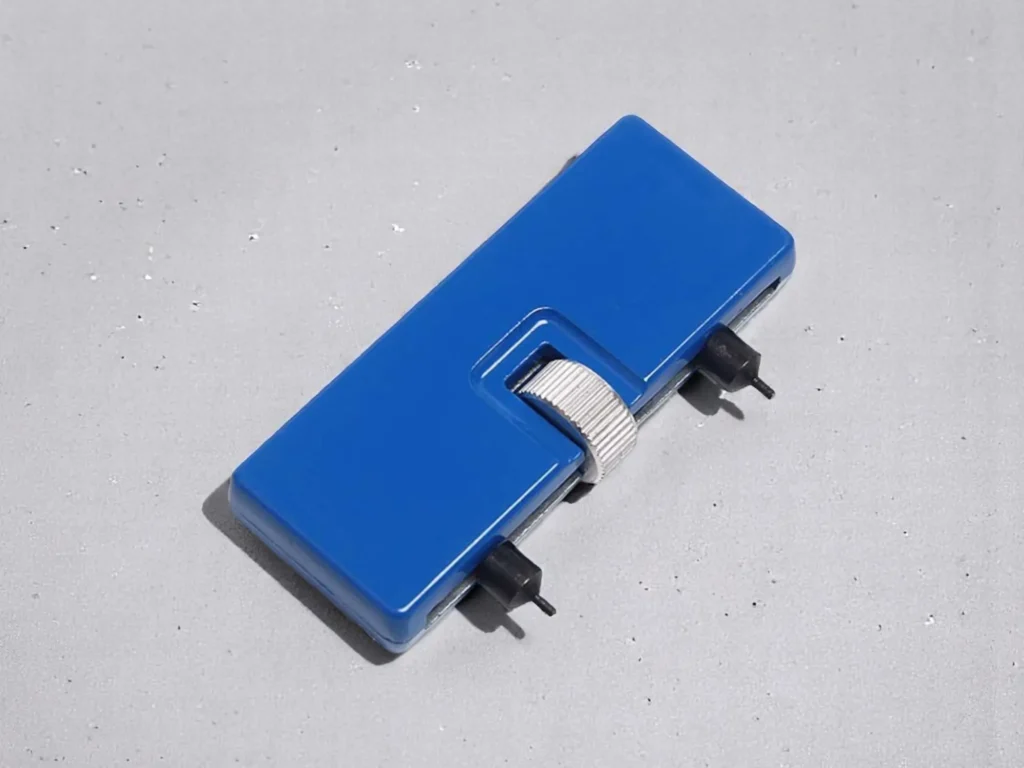
When selecting a wrench, consider:
- The range of adjustment (broader is better)
- Pin quality (hardened steel prevents slipping)
- Handle ergonomics (affects your grip strength)
The Jaxa-style wrenches dominate this category because they adjust to fit almost any notched watch back. But here’s a pro tip: cheaper versions often have pins that break or slip under pressure. If you only open watches occasionally, the Jorest watch wrench with spring bar offers solid value without breaking the bank.
4. Jaxa Wrench for Multi-Notched Backs
The premium tool for serious watch tinkerers, a Jaxa wrench features three adjustable pins that can be positioned to match virtually any notch pattern.
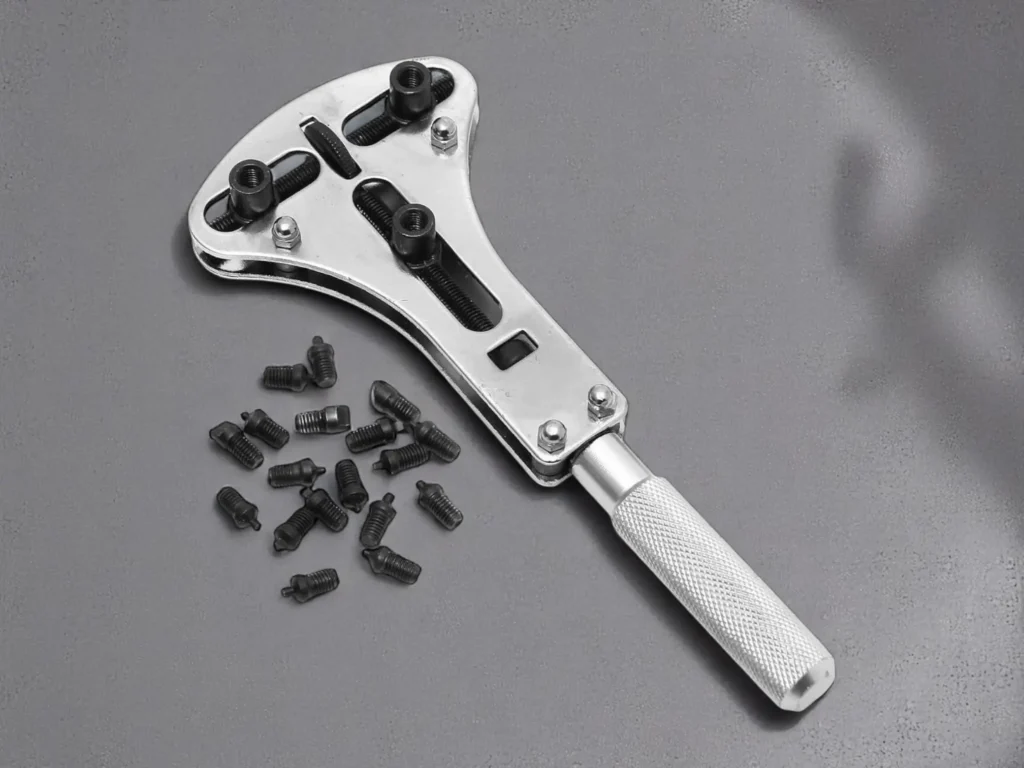
What separates good from great Jaxa wrenches:
- Precise pin adjustment mechanisms
- Hardened steel construction
- Smooth turning operation
- Stable grip even under pressure
While genuine Swiss Jaxa wrenches cost upwards of $100, the German-made Selcraft offers 90% of the functionality at half the price. For occasional use, even entry-level options like the Timewheel’s Jaxa Wrench provide acceptable results.
5. Rolex-Style Case Back Tool
Rolex and similar luxury watches use a distinctive fluted edge case back that requires a specialized opener. These tools feature adjustable “teeth” that grip the fluted edge without damaging the finish.
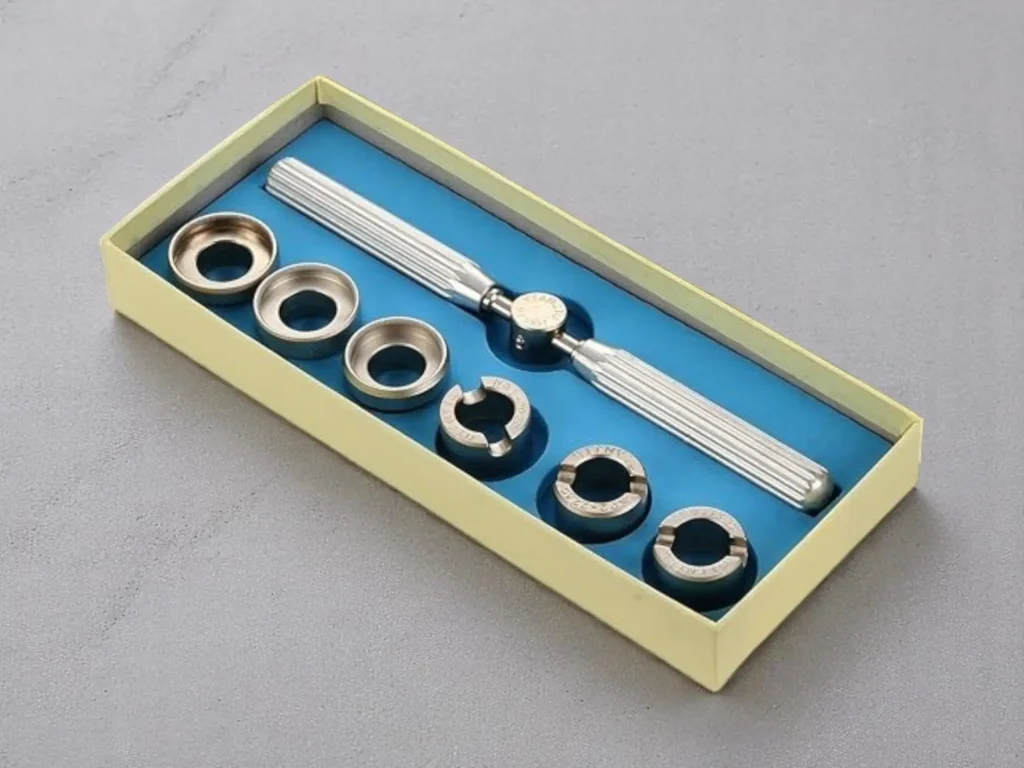
Key qualities in a Rolex case back opener:
- Properly sized teeth that match the case fluting
- Adjustable grip width to accommodate different models
- Non-marring contact surfaces
- Substantial leverage for tightly sealed cases
The Omega & Rolex style caseback openers from Amazon work well without breaking the bank. For those working on multiple luxury watches, investing in a purpose-built tool like the Bergeon 5700-Z saves time and prevents costly case damage.
6. Precision Screwdrivers for Screw-Fixed Backs
Many watches secure their backs with tiny screws around the perimeter. These require precision screwdrivers with perfectly fitting tips.
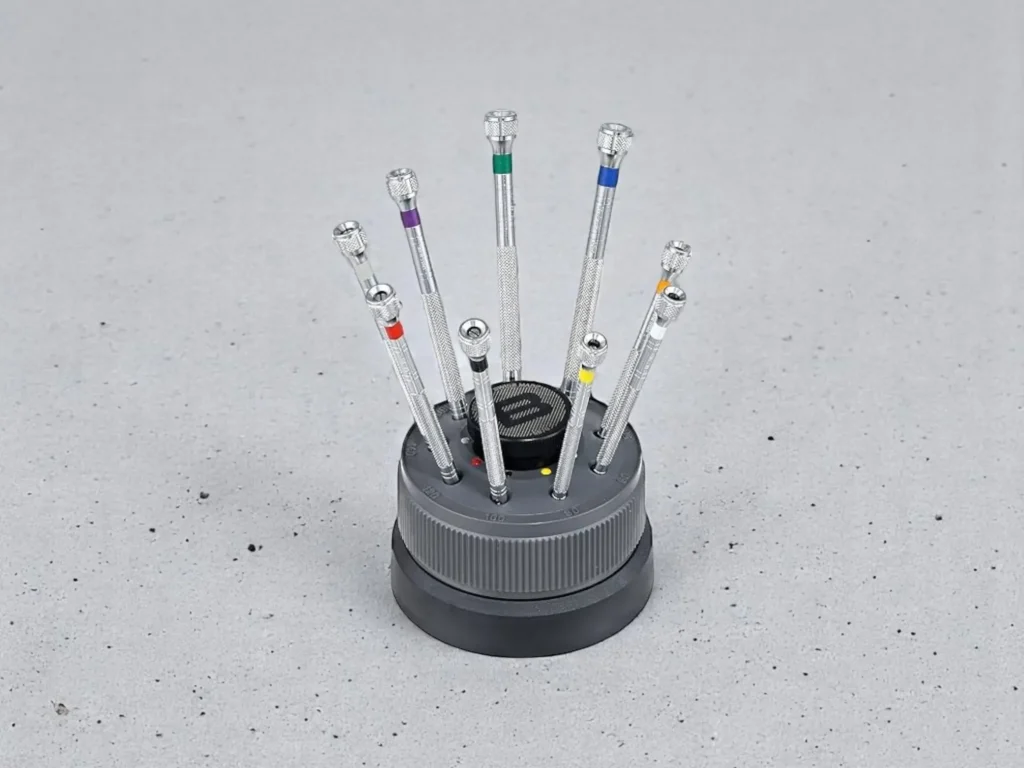
What to look for in watchmaking screwdrivers:
- Hardened steel tips with precise dimensions
- Rotating caps for finger pressure
- Knurled body for secure grip
- Proper blade thickness for watch screws
The Bergeon 55-613 Set of Screwdrivers (9 Piece) offers exceptional value for watch enthusiasts. Each driver features rotating caps for precise control and perfectly sized tips that won’t strip delicate watch screws.
7. Watch Press for Press-Fit Backs
Some watch backs—particularly waterproof ones—require even pressure to snap back into place. A watch press provides controlled force without the risk of misalignment or damage to the watch’s glass.
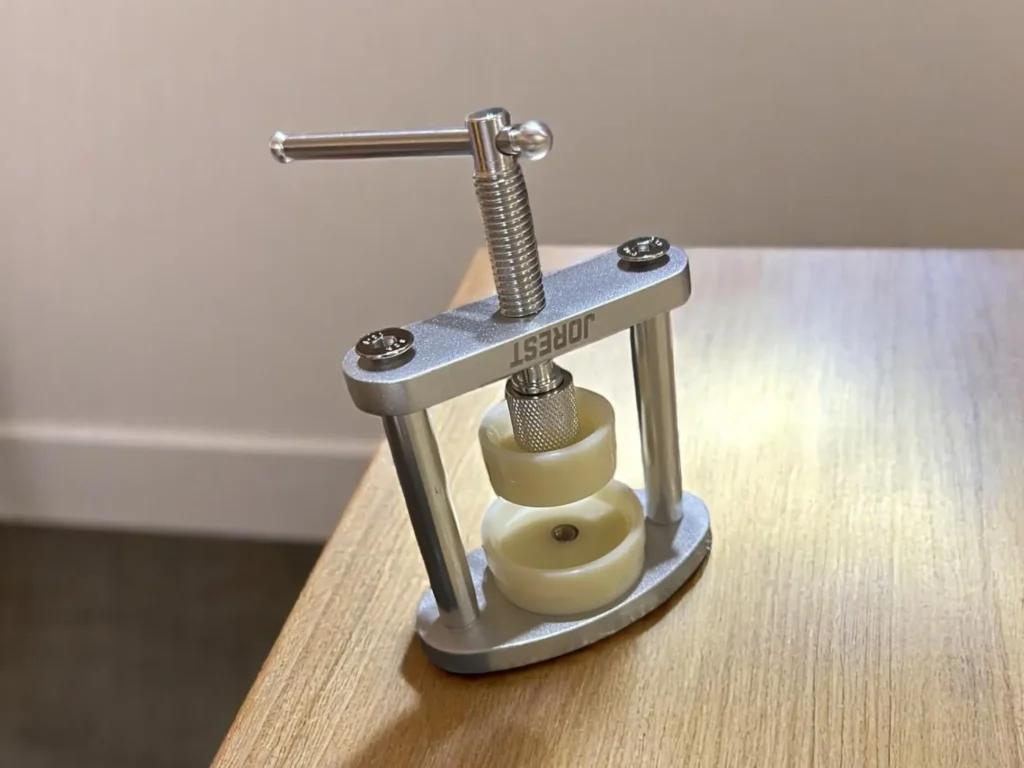
Key features of a quality watch press:
- Stable base
- Various-sized dies (attachments)
- Smooth pressure mechanism
- Proper alignment guides
The Jorest’s Watch Press Tool includes 8 dies covering most watch sizes and costs around $10—a bargain considering how it simplifies reassembly.
Step-by-Step Guide to Removing Different Watch Backs
Opening a Snap-on Back
- Place your watch face down on a soft cloth
- Locate the small notch or lip (usually near the 6 o’clock position)
- Insert your case knife at a shallow angle into this notch
- Gently apply leverage—don’t pry forcefully
- Listen for the satisfying “pop” as the back releases
The most common mistake here? Inserting the knife too deeply. You only need 1-2mm of the blade under the lip to create effective leverage.
Removing a Screw-Down Back
- Secure your watch in a case holder or between cushioned vise jaws
- Position your watch back wrench with pins aligned perfectly in the notches
- Turn counterclockwise with firm, steady pressure
- Maintain even downward force while turning
Remember: leverage matters more than strength. A longer-handled wrench makes removal easier than muscling a small tool.
Using a Watch Back Ball
- Press the rubber ball firmly against the screw-down back
- Apply downward pressure while turning counterclockwise
- If the back doesn’t budge, try wearing a rubber glove for extra grip
- For stubborn backs, cooling the watch slightly can help contract the metal
This method works about 70% of the time on standard screw backs. If your watch has been sealed for years or has a particularly tight back, you’ll likely need to graduate to a dedicated wrench.
Working with Rolex-Style Backs
- Select the correct size opener for your watch case diameter
- Adjust the tool’s “teeth” to match the fluting pattern
- Position the tool so the teeth engage fully with the case fluting
- Apply firm, steady pressure in a counterclockwise direction
- Keep the tool perfectly aligned to prevent slipping
Patience is crucial here—rushing often leads to slipped tools and scratched cases. Many watchmakers place a thin piece of plastic tape on the case sides as protection while working with these tools.
Removing Screw-Fixed Backs
- Place the watch on a soft work surface
- Identify the screw pattern and size
- Select the appropriate precision screwdriver
- Remove screws in a cross-pattern (similar to changing a car tire)
- Store tiny screws in a secure container—magnetic parts trays work well
- Gently lift the case back once all screws are removed
Pro tip: Take a photo of the screw pattern before disassembly—some watches use different length screws in specific positions. Your future self will thank you during reassembly.
Budget-Friendly Options That Actually Work
You don’t need to spend hundreds on tools if you’re an occasional watch tinkerer. Here are the most practical options that deliver real value:
All-in-one kits have revolutionized the accessibility of watch repair. For about $30, kits like the Eventronic Watch Repair Tool Set include basic versions of most tools you’ll need. While not professional quality, they handle most common watches effectively.
Specialized budget tools sometimes outperform their all-in-one counterparts. The single-purpose $6 Jorest watch opener works surprisingly well on many screw cases.
Improvised solutions can work in a pinch. A rubber jar opener grips some screw backs well enough to open them, while a ball of duct tape (sticky side out) sometimes provides enough friction to turn stubborn cases.
The key is matching your investment to your needs—if you’re only changing batteries once a year, a mid-range kit offers the best balance of functionality and value.
Professional Tools Worth the Investment
For those who work with watches regularly, professional tools quickly pay for themselves through:
Consistency of performance: The Bergeon 5700-Z opener might seem expensive until you realize it will still work flawlessly after opening 1,000+ watches.
Reduced damage risk: Quality tools minimize the chance of scratched cases, stripped notches, or broken components.
Time savings: Professional-grade equipment like the Horotec waterproof case opener turns a five-minute struggle into a 30-second job.
Expanded capabilities: The Bergeon 4040 watch vise securely holds virtually any case shape, making impossible jobs merely challenging.
Professional watchmakers consistently recommend Bergeon and Horotec for serious enthusiasts. While expensive, these brands offer precision-manufactured tools that maintain accuracy after years of use.
Common Mistakes and How to Avoid Them
Even with the right tools, watch back removal can go wrong. Here’s how to avoid the most frequent pitfalls:
Using improper leverage damages both watches and tools. Always apply force in the correct direction—usually parallel to the watch back, not toward the crystal.
Working on an unstable surface leads to slippage and scratches. A proper watch holder prevents the case from spinning while you work.
Forgetting gasket maintenance causes water resistance failure. After opening water-resistant watches, always check the gasket for damage and apply a tiny amount of silicone grease before resealing.
Mismatched tool selection causes most damage. Using a case knife on a screw-down back typically results in scratches and frustration.
When to Call in the Professionals
Some watches simply require expert handling:
- Vintage timepieces with irreplaceable parts
- High-end luxury watches with warranty considerations
- Complicated chronographs or mechanical watches
- Watches with damaged or stripped backs
- Deeply sealed waterproof cases (especially dive watches rated beyond 200m)
Many local jewelers charge $15-30 for battery replacements with same-day service. For special cases like these, the professional route often saves money in the long run by preventing costly mistakes.
Final Thoughts
The right watch back removal tools transform a potentially risky job into a simple home maintenance task. Whether you’re looking to save money on battery replacements or developing a deeper interest in watch mechanics, starting with proper tools makes all the difference.
For most people, a quality case knife, entry-level Jaxa-style wrench, and a watch back ball handle 90% of the watches you’ll encounter. Add a simple case press for reassembly, and you’ve covered the essentials for under $70 total.
Remember that patience matters more than force—watches are precision instruments that respond better to technique than strength. Take your time, use the right tool for your specific watch back, and you’ll soon wonder why you ever paid someone else to do this simple job.